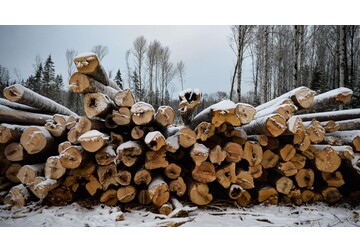
Trump’s Wood Tariffs Are Coming. Who Will Be Hit Hardest
President Donald Trump unveiled sweeping tariffs on imported lumber and wood products that his administration says are needed to protect the US economy and boost domestic manufacturing. Starting Oct. 14, softwood lumber will face 10% duties, while kitchen cabinets, bathroom vanities, and other finished wood goods will be hit with 25% tariffs that rise further in January.
The biggest blow will fall on Canada, the US’s top lumber supplier, whose lumber exports are already subject to separate duties totaling 35.19%. The two countries have been locked in a decades-long dispute over US claims that Canada unfairly subsidizes its lumber industry and sells the commodity below market rates.
US homebuilders and retailers warn that higher costs could push housing prices and furniture costs higher as the trade fight over wood products escalates once again. Here’s what to know.
What exactly did Trump announce on lumber and wood products?
On Sept. 29, Trump announced 10% tariffs beginning Oct. 14 on imports of softwood timber and lumber, as well as levies on kitchen cabinets, vanities and other wood products that initially start at 25%. In January, the fees on kitchen cabinets and bathroom vanities will increase to 50% and on upholstered furniture to 30%.
The duties follow a Commerce Department probe launched in March on the national security impacts of importing lumber and related goods. That so-called Section 232 investigation determined that “present quantities and circumstances of wood product imports are weakening our economy,” leading to mill closures and supply chain disruptions, according to a White House statement. Trade groups representing American industries, including the US Lumber Coalition and the American Kitchen Cabinet Alliance, said the measures would boost domestic manufacturing.
The president has previously leveraged Section 232 to place tariffs on other goods, such as steel and aluminum, and other investigations are still ongoing.
How does this impact Canada?
Canada, which ships more than half of its lumber production to the US, will be the country hardest hit by the tariffs. The 10% duty is expected to stack on top of 35.19% duties on the country’s softwood lumber already in place. Those fees, which were announced in summer 2025, are re-evaluated each year by the Commerce Department in a separate investigation dating back to 2017. These so-called countervailing and anti-dumping duties — meant to counter what the US says are unfairly subsidized exports — have already helped the US South overtake British Columbia as the dominant player in the North American lumber market. Mills in Canada have been curbing output and shutting plants in recent years, a trend that is expected to continue.
Canada has been trying to rescue its forestry industry, including by pledging as much as C$1.2 billion ($860 million) of financial support in August. But the country is also treading cautiously for fear of worsening the dispute. The government in September withdrew two formal trade challenges it had previously filed against the US over tariffs imposed between June 2017 and December 2019.
Which other countries are affected?
Though Canada dominates exports of lumber to the US, many other countries export wood products to the US. The Section 232 tariffs on lumber and wood products affect them in varying ways; some countries benefit from trade deals with the US that cap the rates, and others bear the full brunt.
The European Union, which struck a trade deal with Trump in July, won’t face any fees on exports of its finished wood products above 15%. Japan also has a 15% limit, while the UK has fees capped at 10%. Tariffs on Brazilian lumber and wood products covered by Section 232 will actually decrease: The products will no longer be subject to the previous 40% tariffs that Trump announced on imports from the country in July.
China – one of two largest exporters of wood furniture to the US in 2024 along with Vietnam – won’t be as lucky. In addition to the tariffs announced on Sept. 29, wooden cabinets and vanities from China are also subject to additional anti-dumping and countervailing duties, like those levied on Canadian lumber. The latest fees mark a further blow to US companies that had either shifted manufacturing to China or opted to buy directly from Chinese makers to lower costs.
Why is lumber a recurring source of trade tension between the US and Canada?
At the heart of the matter are the so-called “stumpage rates” that sawmills pay to Canadian provincial governments to harvest timber in government-owned forests. The US says those fees are below market rates and are equivalent to a government subsidy, and has at times put in place its own anti-dumping and countervailing duties to counterbalance them. Canada denies that it sets low stumpage rates to undercut the market.
The latest round in the dispute began in 2016, after a US-Canada lumber agreement signed about a decade prior lapsed. The US lumber industry filed a petition to re-impose high fees on Canadian exports, which are re-evaluated every year.
Can the US just produce more lumber instead of importing it?
The US has large swaths of unexploited forests, and Trump committed to expanding domestic timber production in a March executive order that directed federal agencies to streamline permitting and reduce regulatory limits. However, though the US has some spare capacity to turn more timber into construction materials, a fully domestic supply chain would likely still require the construction of new sawmills and additional trained workers to operate the facilities — needs complicated by an immigration crackdown — which would slow the transition from foreign lumber.
Another factor for US suppliers and buyers is that US and Canadian lumber are not a perfect swap. The southern yellow pine species, which has accounted for much of the US industry’s expansion, grows faster than Canada’s spruce pine fir. But the spruce pine has long been favored because it’s easier to work with and reacts less to changes in moisture.
What do the duties mean for US consumers?
Though lumber accounts for less than 20% of building costs, the National Association of Homebuilders has long said that restrictions on Canadian lumber translate to higher construction costs. In 2018, after duties on Canadian lumber were put back in place, many homebuilders resorted to using cheaper southern yellow pine, building smaller homes and changing designs to use fewer materials.
Any added fees in theory translate to pricier construction materials. As of October 8, lumber futures in Chicago were trading at a premium of about $205.5 per 1,000 board feet over southern yellow pine lumber.
Still, markets don’t always work in straightforward ways. In September, prices slumped to their lowest in seven months despite the batch of duties on Canadian lumber imposed over the summer. The duties failed to offset weaker housing demand resulting from poor consumer confidence.
Those still moving forward with new home purchases are also likely to pay more to furnish their spaces. The Home Furnishings Association, which lobbies for home goods retailers, has already advised its members to prepare for increased costs due to tariffs.
bloomberg.com







